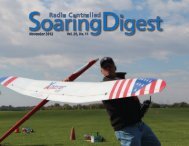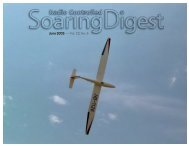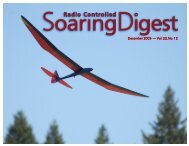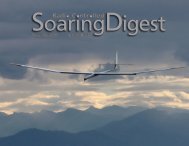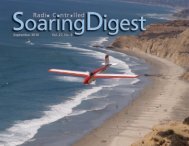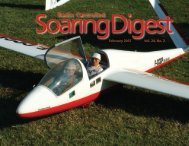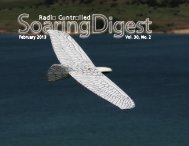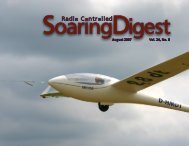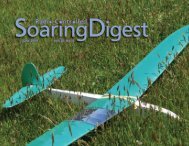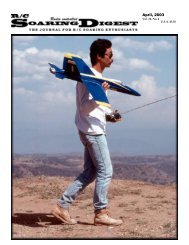August 2006 Vol. 23, No. 8 – R/C - RCSoaring.com
August 2006 Vol. 23, No. 8 – R/C - RCSoaring.com
August 2006 Vol. 23, No. 8 – R/C - RCSoaring.com
Create successful ePaper yourself
Turn your PDF publications into a flip-book with our unique Google optimized e-Paper software.
which two slots need to be cut in the<br />
fuselage. I checked the re<strong>com</strong>mended CG<br />
range for the Soprano and then measured<br />
the locations for making the slots so that I<br />
could keep the towhook within the range<br />
of adjustment for the CG.<br />
I then chose to add a skeg from Superskeg<br />
to the model, using the V-Skeg (Part SK-4).<br />
This is an injection molded polyethylene<br />
piece with two screws included. The<br />
instruction sheet explains how to go about<br />
making up the mounting plate and also<br />
gives you a template for drilling the three<br />
holes to mount the skeg to the fuselage<br />
The plywood mounting plate was glued<br />
inside the fuselage using<br />
Zap-A-Dap-A-Goo. Once that had cured,<br />
I drilled the three holes needed to mount<br />
the skeg and checked that the fit was good<br />
and properly centered.<br />
The Soprano manual calls for using foam<br />
bulkheads for supporting the pushrods<br />
down the length of the tailboom. The<br />
drawings in the manual are not to scale but<br />
I simply measured up the cross section in<br />
the three locations where the foam would<br />
be located and, using a contour gauge,<br />
worked out the shape and cut the foam<br />
parts as needed. I then determined where<br />
the pushrods would pass through the<br />
foam, and glued in short sections of scrap<br />
pushrod housings through each foam<br />
bulkhead.<br />
To help get them in the correct location<br />
within the fuselage, I made up the elevator<br />
pushrod (using the 0.125 inch diameter<br />
carbon fiber tube) and attached it to the<br />
bellcrank in the fin. I then slid the foam<br />
bulkheads down the pushrod using a<br />
length of spruce marked with the<br />
distances I needed to push in each<br />
bulkhead.<br />
This method worked well for me and gave<br />
me a slop free, low friction support for the<br />
pushrods.<br />
With the bulkheads in place, I drilled out<br />
the nose piece to accept the pushrods and<br />
also installed the antenna tube. I also<br />
drilled two larger diameter holes in the<br />
wing saddle of the fuselage pylon to allow<br />
for future access to the internal towhook<br />
plate should I need to adjust it further and<br />
to give me access for the servo lead to the<br />
spoiler servo. I may also use one of the<br />
openings at a later date for an additional<br />
ballast tube.<br />
With everything in place and final dry fit<br />
check of all parts, I then proceeded to glue<br />
the nose piece to the main fuselage,<br />
placing the epoxy only on the main<br />
fuselage so that as the nose piece was<br />
pushed into place, the epoxy would not<br />
end up on the exposed portion of the nose<br />
piece and leave excess epoxy where it<br />
would cause fit problems for the nose<br />
cone. I used the nose cone to ensure the<br />
nose piece was properly fitted and the nose<br />
cone would fit correctly when the epoxy<br />
had cured.<br />
It was now time to move onto the wing.<br />
The only thing that needed to be done<br />
with the wing was to fit the spoiler servo<br />
and its associated linkage. Timing was in<br />
my favor as the February <strong>2006</strong> issue of<br />
R/C Soaring Digest had just been posted<br />
and Lee Murray’s article “Live Hinge<br />
Spoiler Installation in an Organic RES”<br />
addressed what I needed to do with the<br />
Soprano’s set up. I duplicated Lee’s set up<br />
from the article and had a nicely working<br />
spoiler in no time.<br />
If you are looking for a different source<br />
than the Radio Shack magnet mentioned<br />
in Lee’s article, I have found that there is a<br />
line of magnetic toys available at WalMart<br />
that may just do the trick. Called<br />
Magnetix, these are small but powerful<br />
magnets mounted in plastic sticks that,<br />
along with the provided ball bearings,<br />
make up into various geometric shapes.<br />
You can check out the product line at<br />
.The magnets are<br />
easily removed from the plastic housing<br />
and are as powerful or nearly so as the<br />
magnet available from Radio Shack. The<br />
cost is considerably less as well.<br />
The wing attachment bolts are actually<br />
two different sizes - M4x20mm for the<br />
two main wing bolts, and M4x16mm for<br />
the aft wing saddle location. Be careful to<br />
select the correct bolt size as the shorter<br />
bolt will not pick up the threads if used in<br />
the forward location.<br />
To keep myself from making a mistake at<br />
the field, I went to my local hardware store<br />
and picked up some spares for the field box<br />
and standardized on the longer bolts for all<br />
<strong>August</strong> <strong>2006</strong> 9



